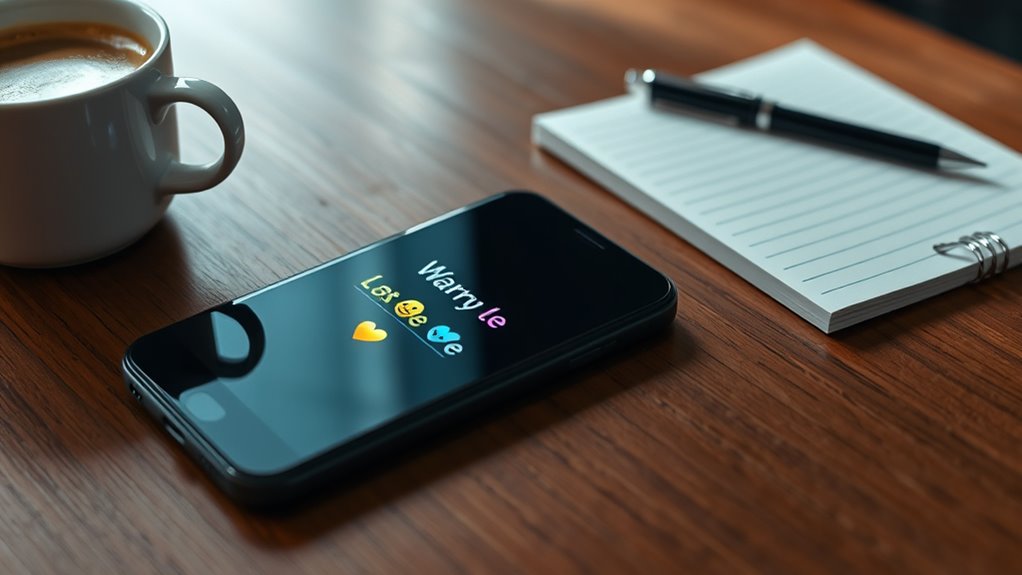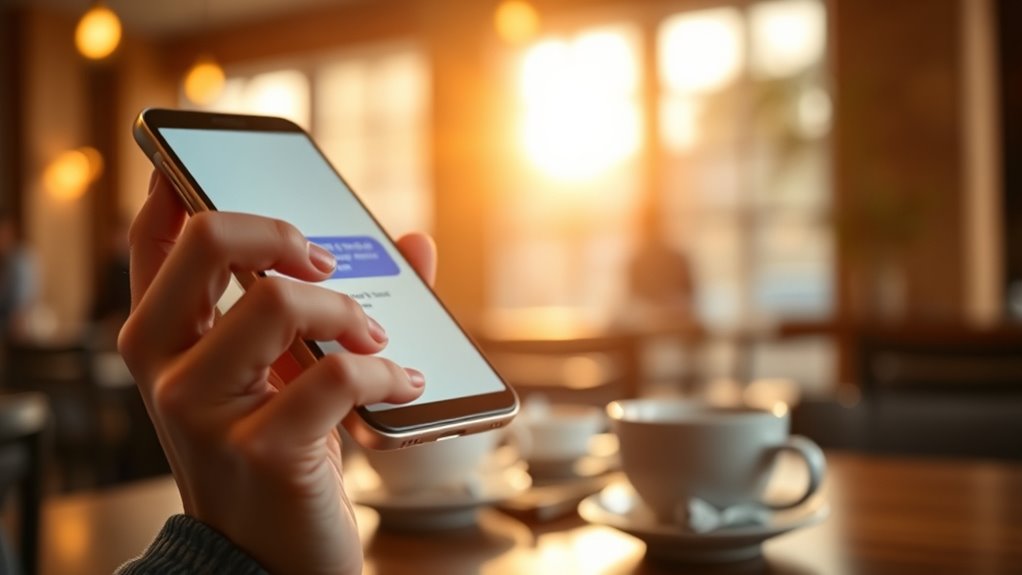To start a conversation that gets a reply, personalize your opening based on their profile or interests. Avoid generic greetings—be genuine, friendly, and specific with your questions or comments. Incorporate humor or light-hearted remarks to break the ice and stand out. Show real interest and effort, so your message feels thoughtful and engaging. Stick with natural, relevant comments, and if you continue, you’ll discover more effective ways to craft memorable first messages.
Key Takeaways
- Personalize your message by referencing specific details from their profile or photos.
- Start with a friendly greeting followed by a genuine comment or thoughtful question.
- Use humor or light-hearted remarks to create a memorable and engaging opening.
- Demonstrate attentiveness and curiosity to show authentic interest in their interests.
- Keep the tone natural and conversational, avoiding generic openers to stand out.

Have you ever wondered why some first messages instantly spark a connection while others fall flat? It’s a common question, and the answer often lies in how you approach that initial contact. When reaching out, your goal is to stand out, grab attention, and make the other person want to reply. That’s where icebreaker strategies come into play. Instead of sending a generic “Hi” or “What’s up?”, you need to craft a message that feels genuine and tailored to the recipient. The key is message personalization — showing that you’ve paid attention to their profile, interests, or shared experiences.
Effective icebreaker strategies start with a quick scan of their profile or online presence. Look for something unique, a hobby, a recent trip, or a shared passion. Use that information to craft a message that resonates. For example, if they mention loving hiking, you might say, “I saw you’re into mountain trails. Do you have a favorite hike that you’d recommend?” This shows you’ve taken the time to learn about them and aren’t just sending a cookie-cutter message. Personalization sparks curiosity and makes it easier for them to respond because your message feels relevant and thoughtful.
You want your message to feel natural and engaging, not forced or overly rehearsed. Start with a friendly greeting, but follow it with a specific comment or question related to something they’ve shared. Avoid generic openers like “Hey, how are you?” Instead, try something that invites a response, such as commenting on their recent photo or a hobby they mention. This not only demonstrates your interest but also gives them an easy way to reply. Remember, people respond better when they feel seen and appreciated for who they are, not just as a profile or a name.
Another effective tactic is to incorporate humor or light-heartedness if it suits your style. A playful comment or a clever remark can break the ice and make your message memorable. However, ensure your humor is respectful and appropriate. Keep it simple, genuine, and relevant. The goal is to create an opening that feels less like a pitch and more like a conversation starter. When you combine icebreaker strategies with message personalization, you profoundly increase the chances of getting a reply.
Ultimately, your first message should convey that you’re interested, attentive, and willing to take the initiative. A well-crafted, personalized opener shows effort and genuine curiosity, which are attractive qualities. When you master these techniques, you’ll find that starting conversations becomes easier, and those initial exchanges can lead to meaningful connections. So next time you reach out, remember: a thoughtful, personalized message is your best tool to turn a cold start into a warm conversation.
Frequently Asked Questions
How Can I Tell if My Message Is Too Forward?
You can tell if your message is too forward by paying attention to tone mismatch and emoji overuse. If your message feels overly intense or too personal compared to your recipient’s style, it’s a sign you might be too forward. Also, using too many emojis can come across as overly enthusiastic or insincere. Keep your tone friendly and balanced, and avoid overloading messages with emojis to stay respectful and approachable.
What Are Some Common Mistakes to Avoid in First Messages?
When crafting your first message, avoid common mistakes like using an inappropriate message tone or failing to incorporate effective icebreaker strategies. Keep your tone friendly and genuine, steering clear of overly formal or casual language. Don’t be too vague or generic—personalize your message to show genuine interest. Also, avoid being overly forward or pushy, as it can turn people off. Focus on engaging, thoughtful icebreakers that encourage a response.
How Do I Personalize Messages Without Sounding Generic?
To personalize messages without sounding generic, focus on using personalization techniques like mentioning specific interests or recent activities from their profile. Keep your message tone genuine and friendly, avoiding overly formal or robotic language. Show that you’ve paid attention by referencing details that matter to them. This approach makes your message stand out and feels authentic, increasing the likelihood of getting a response and building a real connection.
What Timing Considerations Improve Reply Rates?
Imagine you send a message at 8 PM, catching someone during their evening unwind. Your message timing affects response window; replying during their free moments increases reply rates. To maximize engagement, consider when your recipient is most active—typically evenings or lunch hours. Avoid busy mornings or late nights. By timing your messages thoughtfully, you stay within their ideal response window, boosting your chances of getting a reply quickly and effectively.
How Should I Handle No Responses or Negative Replies?
When you get no responses or negative replies, you should practice good reply etiquette by remaining polite and respectful. Adjust your message tone to be friendly and understanding, avoiding blame or frustration. Give it some time before reaching out again, perhaps with a different approach or new context. Remember, persistence and kindness often turn negative responses around and increase your chances of getting a positive reply next time.
Conclusion
Mastering the art of the first message is like planting a seed in fertile soil—you set the stage for growth and connection. When your words sparkle with authenticity and curiosity, they act as a beacon, guiding your conversation to bloom into something meaningful. Remember, every great journey begins with a single step; so, craft your opening with care, and watch how your message sparks a chain reaction, turning a simple hello into a pathway to new possibilities.










